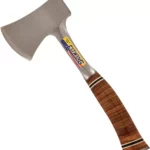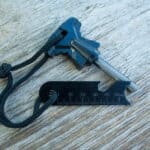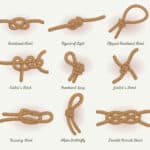Building a DIY solar power system for survival is about harnessing the sun’s clean, free energy daily. Solar power has grown rapidly and become more affordable, making it an excellent choice for long-term survival.
This system includes components like solar panels, batteries, charge controllers, and inverters to ensure you have power when you need it most. The average US household uses about 30 kilowatt-hours of electricity each day.
Knowing this helps you plan your solar setup to meet your energy needs effectively. Companies such as SunPower and Tesla Energy offer reliable parts for these systems. With regular checks on fuses and breakers, a solar power system can last longer and perform better.
Dive into how to build and maintain your own system next!
Table of Contents
- Why Choose Solar Power for Survival?
- Basics of a Solar Power System
- Planning Your Survival Solar System
- Building Your Own Solar Power System
- Maintenance and Troubleshooting of Solar Power System
- Conclusion
- FAQ
- What are the main components needed to build a solar power system?
- How much electricity does the average US household use per day?
- What are some factors to consider when planning a survival solar power system?
- What maintenance is required for solar panels?
- What are some common problems that can occur with solar power systems?
- What should be considered when choosing a location for solar panels?
- What permits and inspections are typically required for a solar power system installation?
- What are the benefits of using lithium batteries over lead-acid batteries in a solar power system?
- What are some costly mistakes to avoid when designing a solar power system?
- What are the steps involved in a typical DIY solar panel installation?
Why Choose Solar Power for Survival?
Moving from understanding the need for survival preparations, solar power stands out as a smart choice. It’s affordable and quickly becoming more popular. Solar energy is clean and always there for us to use.
Plus, it’s free once you have the gear.
The US faces threats like bad weather, earthquakes, and attacks that can break our power systems. Remember how eight states lost electricity in 2003? A solar setup helps keep lights on when those systems fail.
Solar equipment means staying ready and safe in emergencies or natural disasters.
Basics of a Solar Power System
A solar power system turns sunlight into electricity you can use. It needs panels, batteries, a controller, and an inverter to work right.
Solar Panels
Solar panels catch sunlight and turn it into electricity. They are key for a survival solar power system. These panels use photovoltaic cells to do this job. The more sunlight they get, the more power they produce.
You want them placed where they can get lots of sun all day.
Choosing the right solar panel matters for your energy needs. There are different types, like monocrystalline and thin-film. Monocrystalline is efficient in sunny places, while thin-film works well even when it’s not very sunny but takes up more space.
Think about how much electricity you need and pick the type that fits best.
Battery Bank
After capturing sunlight with solar panels, we need a place to store that energy. Enter the battery bank—this is where power waits until you need it. Battery banks are made of many batteries linked together.
They save electricity for when the sun doesn’t shine.
Choosing the right battery type matters a lot. Lead-acid and lithium-ion are popular choices, each with its pros and cons. The size of your battery bank depends on how much power you use daily and how many sunny hours your area gets.
More batteries mean more stored energy but also require more space and money.
Charge Controller
Moving from the battery bank to another vital part, we have the charge controller. This device ensures that the right amount of electricity flows into your batteries. It’s key to keeping them safe and making them last longer.
The charge controller stops your batteries from getting too much power, which can harm them.
It also makes sure your solar panels and batteries work well together. Choosing the right size and type of charge controller boosts your system’s performance. Without it, you risk damaging your whole setup by overcharging or underperforming batteries.
Inverter
An inverter changes DC power from batteries into AC power. This lets us run household devices like fridges and laptops using solar energy. Choosing the right inverter is key to a system’s efficiency.
There are many sizes and types, including high-efficiency models, to match different energy needs.
This part of your solar setup is vital for long-term survival. It makes sure that the energy saved in your batteries can power essential equipment during emergencies. Proper installation ensures that this link between stored solar power and usable electricity at home works well, keeping lights on and food cold when needed most.
Planning Your Survival Solar System
Planning your solar system starts with understanding your energy needs. It means knowing how much power you use daily and choosing the right components to meet those needs.
Calculate Your Daily Energy Consumption
Knowing your daily energy use is key to building a solar power system for long-term survival. The average US household uses about 30kWh per day, but you might use more or less.
- List everything that uses electricity in your home. Think about lights, fridge, TV, and other gadgets.
- Check how many watts each item uses. Find this info on the label or manual.
- Note how many hours you use each item daily. A light might be on for 5 hours, but a fridge runs all the time.
- Multiply the watts by hours to get watt – hours (Wh) per day for each item. Add them all up for a total.
- Consider days with less sun. Some days have clouds or rain, so plan to have extra power for those days.
- Think about essential vs. non-essential items. Maybe you can skip some devices to save power.
This calculation shows how much power you need each day from your solar system. It helps you choose the panels and batteries that are the right size to meet your needs without wasting resources.
Select the Right Battery
Choosing the right battery is key for your solar power system. Golf cart and deep cycle industrial batteries are best for this job. They have enough amp-hours to keep your inverter running smoothly.
Make sure the number of batteries matches the number of panels.
Your system needs a strong backbone, and these batteries offer just that. They store energy efficiently, making sure you have power when you need it most. Keep an eye on balance—too few batteries won’t cut it, too many might not be necessary.
Determine the Battery Bank Size
Picking the right battery bank size is vital for your solar power system’s success. You need enough storage to keep your lights on and appliances running, especially during emergencies.
- Start with understanding your power needs. Look at how much energy you use daily. The average American home uses about 30kWh per day.
- Match your daily consumption with the battery capacity. This means if you use 30kWh a day, your battery bank should be able to store that much, at least.
- Keep in mind that solar panels don’t produce power all the time. Days can be cloudy or short in winter. So, it’s smart to have extra storage—aim for three days’ worth of energy as a safety net.
- Consider your solar panel output. More panels mean more power but also require more storage to make full use of excess energy produced during sunny days.
- Battery efficiency plays a role, too. Not all stored energy is usable—lead-acid batteries offer about 80-90% usability, while lithium-ion batteries can give back up to 95%.
- Think about future needs as well. Will you add more appliances? If yes, plan for a bigger battery bank now to avoid costly upgrades later.
- Lastly, factor in battery lifespan and depth of discharge (DoD). Discharging a battery fully shortens its life; thus, having a larger bank minimizes deep discharges and extends overall battery life.
Next up: choosing the right system voltage for your setup.
System Voltage
System voltage is key in planning a solar power system. It tells how much electricity your setup can handle and use. Most home systems work with 12, 24, or 48 volts. The right choice depends on how much power you need every day.
More daily use often means a higher system voltage is better.
Choosing this requires thinking about all parts of your solar setup – panels, batteries, inverter. Make sure they match in voltage for safe and effective operation. After getting the system voltage set, the next step involves picking the right solar panels for your needs.
Building Your Own Solar Power System
Crafting your own solar power system opens a path to self-reliance — learn how to harness the sun’s power for long-term survival.
Selecting the Solar Panel
Choosing the right solar panel involves considering size, type, and efficiency. Monocrystalline panels are highly efficient but cost more. Thin-film panels offer flexibility at a lower price but with less efficiency.
Your decision should match your energy needs and budget. Reputable brands like SunPower and LG Solar offer high-quality solar cells and modules.
After picking your solar panel, it’s time to connect them using MC4 connectors for a secure electrical link. Next up – wiring the solar panels together.
Wiring the Solar Panels
After picking the right solar panels, the next step is wiring them together. This part is crucial for your solar power system. Here’s how to connect your panels:
- Identify the positive and negative terminals on each solar panel.
- Use solar cables to connect the panels in a series or parallel setup:
- Series: Link the positive terminal of one panel to the negative terminal of another. This increases the voltage to match the system’s needs.
- Parallel: Connect all positive terminals together, and all negative terminals together. This increases current, useful for larger systems.
Wiring takes patience and attention to detail but sets up your system for success!
Selecting the Charge Controller
Once your solar panels are wired, the next step is picking a charge controller. This small yet critical device manages electricity flow from panels to the battery bank, ensuring batteries charge correctly and stay safe.
You want one that matches your system’s voltage and current output of your solar setup. Go for a quality charge controller to guard against overcharging, helping batteries last longer.
MPPT (Maximum Power Point Tracking) types excel in efficiency, squeezing out more energy from sunlight than others. Choose based on system size—bigger setups need robust controllers.
Always opt for reputable brands to ensure reliability in your solar power system.
Choosing the Right Inverter
Choosing the right inverter is key. It turns DC power from your solar panels into AC power, which can be used to run household appliances. Look for quality, efficiency, and how well it fits with your system’s other parts.
Big names like SunPower and Tesla Energy are good places to start.
Efficiency matters—a lot. A top-notch inverter saves more energy and performs betterJ. Make sure it matches your system’s voltage and has enough capacity for all your needs.
This choice impacts how well your whole solar setup works day-to-day.
Sizing of Fuses / Breakers
After picking the right inverter, we move to protecting our system with fuses and breakers. Their correct size is key for safety. They keep your panels, batteries, and devices safe from too much current that can cause harm.
You must match them with the maximum current your solar setup can handle.
Guidelines from makers help you choose what’s best for your system. Checking these parts often keeps everything running smoothly. They stop problems from power grid failures by keeping your system safe.
Maintenance and Troubleshooting of Solar Power System
Keeping your solar power system running smoothly means checking and cleaning it often. Dust and dirt can block sunlight, so clean your solar panels with water and a soft brush. Check wires and connections for damage or wear.
Tighten loose parts. Make sure batteries hold a charge well. If they don’t, you might need new ones.
Troubleshooting starts with easy steps. If your system isn’t working right, first check if all components are on and connected properly. Look at each part—solar panels, charge controller, inverter, batteries—to find where the problem is.
Most issues result from poor connections or failed batteries. Fixing these can quickly restore your system to good shape.
Conclusion
Building a solar power system for long-term survival makes sense. You get to tap into clean, endless energy from the sun. It’s smart planning, whether you’ve started prepping for emergencies or aiming for an off-grid life.
With the right setup, your home can stay lit, warm, and connected even when everything else fails. Solar power is reliable, and in these uncertain times, it offers priceless peace of mind.
FAQ
Here is the updated FAQ section with the hyperlink citations removed:
What are the main components needed to build a solar power system?
The main components of a solar power system include solar panels, batteries, charge controllers, and inverters. Solar panels convert sunlight into electricity, batteries store the generated energy, charge controllers regulate the flow of electricity from the panels to the batteries, and inverters convert the stored DC power into usable AC power.
How much electricity does the average US household use per day?
The average US household uses about 30 kilowatt-hours of electricity each day. Knowing your daily energy consumption helps you plan your solar setup to meet your energy needs effectively.
What are some factors to consider when planning a survival solar power system?
When planning a survival solar power system, consider your daily energy consumption, climate and sun exposure, solar panel orientation and angle, natural efficiency drop, conversion losses, shading, expandability, and battery size and charging requirements.
What maintenance is required for solar panels?
Solar panels generally require minimal maintenance. At least twice a year, they should be cleaned regularly to remove dust and debris. Periodic visual inspections should be performed to check for damage, loose connections, or other issues. Professional inspections are also recommended annually.
What are some common problems that can occur with solar power systems?
Some common issues with solar power systems include improper installation leading to water leaks, poor racking, or shoddy electrical work; inverter failures; animal damage from rodents or birds; communication issues due to internet connectivity problems; and reduced efficiency from shading, soiling, or aging of components.
What should be considered when choosing a location for solar panels?
When selecting a location for solar panels, ensure the area has ample sun exposure and minimal shading from trees or structures. The panels should ideally face south for optimal energy production, but east or west-facing orientations can also work well. Consider the roof’s condition and available space for mounting the panels.
What permits and inspections are typically required for a solar power system installation?
Permits and inspections vary by location but often include building permits, electrical permits, and utility interconnection agreements. Inspections may be required at various stages of the installation process to ensure code compliance and safety. Working with a professional installer can help navigate the permitting and inspection requirements.
What are the benefits of using lithium batteries over lead-acid batteries in a solar power system?
Lithium batteries offer several advantages over lead-acid batteries, including longer lifespan, higher efficiency, deeper discharge capability, faster charging, and lower maintenance requirements. They are also lighter and more compact than lead-acid batteries. However, lithium batteries are generally more expensive upfront.
What are some costly mistakes to avoid when designing a solar power system?
Some costly mistakes to avoid when designing a solar power system include undersizing components, mixing old and new batteries, overpaying for installation, and building a piecemeal “Frankenstein” system with incompatible parts. Proper system sizing, using compatible components, and working with experienced professionals can help avoid these pitfalls.
What are the steps involved in a typical DIY solar panel installation?
The basic steps for a DIY solar panel installation include planning the system, obtaining necessary permits, purchasing equipment, installing the racking system, mounting and wiring the panels, installing the inverter and batteries, setting up monitoring, and arranging for final inspections and utility interconnection. Proper safety precautions and following manufacturer instructions are crucial throughout the process.







Leave a Reply